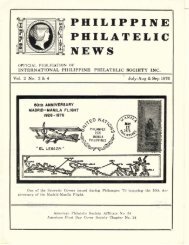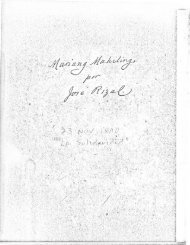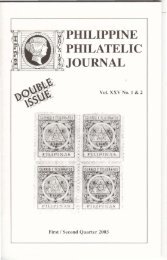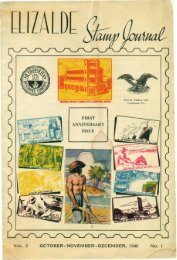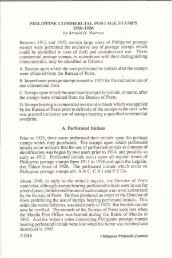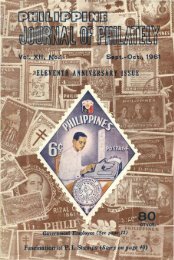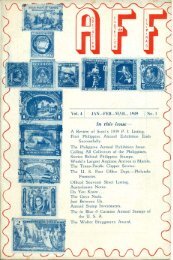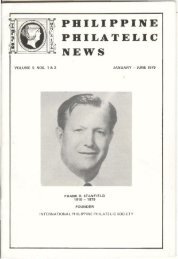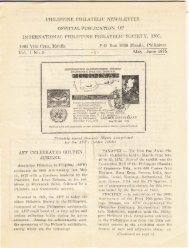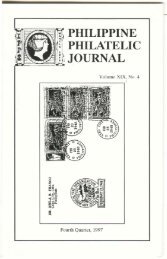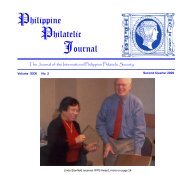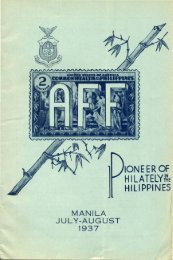April-December 1977, Vol. 3, No.s 2-4 - International Philippine ...
April-December 1977, Vol. 3, No.s 2-4 - International Philippine ...
April-December 1977, Vol. 3, No.s 2-4 - International Philippine ...
Create successful ePaper yourself
Turn your PDF publications into a flip-book with our unique Google optimized e-Paper software.
THE MARCH 4, 1942 ISSUES'<br />
By Marlo Que<br />
Japanese Occupation st~ps and covers of the <strong>Philippine</strong>s are considered by students of <strong>Philippine</strong><br />
philately as one of the most interesting fieJds to study. It is perhaps due to the short 1ife-sp~ of.the O~cupatiOD<br />
and yet the numerous number of areas to research and study. <strong>No</strong> other field of Phllippme Philately<br />
can 'offer such a challenge from the stamps issued to covers prepared - first days and otherwise, to postmarks,<br />
censor marks, postal stationeries, etc... This article will concentrate on March 4. 1942 - the re-opening<br />
of the Postal System during the Japanese Occupation - the issues. etc... surrounding this date.<br />
March 4, 1942 is indeed an important date for <strong>Philippine</strong> philatelists. It was a time when most people<br />
were still unaware of the happneings that surrounded them, a time when fright and anxiety prevailed among<br />
the masses. ]t was perhaps due to the abrupt change of the ruling power that people were uncertain of their<br />
rights - what they could and they could not do. Thus, when Executive Order <strong>No</strong>.4 dated Feb. 21, 1942<br />
laying down the basic guidance for the re-opening of the· postal system within the Oty of Greater Manila<br />
Uta was issued, it paved the way to the re-opening of the post office on March 4, 1942. And, one of the<br />
basic changes that was made was the renaming of the "Bureau of Posts" to "Bureau of Communications".<br />
To meet the postal requirements, a set of stamps was issued - the 2c Rizal, for ordinary mail, the<br />
16c Magellan's Landing for·registered mail; and a 2c Rizal postal card. All of these were part of the seized<br />
Commonweahh issues, re-issued with overprints. Because of the tension still prevailing at that time, it cal1<br />
be said that only a small number ofpeople took timeout to either prepare philatelic covers or mail letters.<br />
THE 2c RIZ~L (SCOTI /I NI): -<br />
Soott 1/ 461, the 2c Rizal apple green, 1941 series, was overprinted with bars deleting the words<br />
"United States of America" and "Commonwealth of the" in black. The stamp, measuring 19 x 22 1/2 mm.,<br />
with \,:erforation 11 and 10 1/2, unwatermarked, was issued in sheets of 100, with no straight edge. Total<br />
quantity issued was 3 million. This particular stamp was originally printed by the United States Bureau of<br />
Engraving and Printing in whole sheets of 400 containing four panes of 100 stamps each. These whole sheets<br />
were cut into four panes for easier packing purposes, before shipping to the Philip\,:ines. So, when the overprinting<br />
was done by the Japanese authorities, there exists four different plate pOSItions, one plate number<br />
per whole sheets, but found in fOUI different positions, namely: (1) upper right hand corner on pane 1;<br />
(2) upper left hand comer on pane 2; (3) lower right hand comer on pane 3, and (4) lower left'hand corner<br />
on pane 4. I have so far obtained the following plate numbers for my collection: 145416 and 145417.<br />
There are two color shade varieties that are known: apple green and bright yellow apple green.<br />
Scott catalogue lists a major error wherein a pair with one stamp with the deleting bars and the other stamp<br />
without the deleting bars. I personally have not seen one. When I examined several sheets of this particular<br />
issue in my collection, and others too, I discovered that the bar deleting the words "United States of America"<br />
is narrower on the rust three stamps of each row, located at the left hand side of each pane, as compared<br />
to .the other succeeding deleting bars.<br />
Electric Eyes - or, the marginal markings used as electronic guides in perforating the sheets - are<br />
found in this particular issue. As mentioned before, the stamps were issued in sheets of 400, and was cut into<br />
four panes of 100 stamps. In between panes 1 and 2 and in between panes 3 and 4, a series of heavy gutter<br />
dashes, dividing the vertical sheet gutter between the left and right panes, were printed. There are twenty of<br />
these gutter dashes, two for each corresponding stamp. A corresponding line (Gutter Bar) was also printed<br />
on the lower left sheet margins of panes I and 3. Horizontal lines (frame bars) were also printed on the left<br />
sheet margins of panes 1 and 3; there are 9 frame bars per pane, one for each corresponding stamp, starting<br />
on the second row, stamp II 11. For clearer understanding, refer to illustration 2.<br />
THE 16c MAGELLAN', LANDING (SCOTI fFN3L<br />
Scott If 439, the 16c Magellan's Landing, dark blue, 1938 series, was overp.r.inted ,with bars deleting<br />
the words "United States of America" and "Commonwealth" in black. The stamp, measQring 22 x 35 mm,<br />
wjth perforation 11, unwatermarked" was issued in sheets of 50, with 14 straight edg~s (13 with singltf7<br />
straight edge, and one with two straight edges). Total quantity issued was 160,000. The stamp was originally<br />
printed by the United States Bureau of Engraving and Printing in whole sheets of 200 containing four<br />
'Panes of 50 stamps each. There exists two different plate positions, one plate per pane (see·illustration 3),<br />
namely: (1) the upper plate number, found on the 3rd stamp of the rust and second panes; and (2) the<br />
lower plate number which is found on the 48th stamp of the 3rd and 4th panes. In my collection, I have<br />
the following plate numbers: 131568, 129937, 131521, and 131567.<br />
A number of varieties exists in the position of the deleting bar on the wprd "Commonwealth". Bars<br />
were either shifted downward or upward, causing the word "Commonwealth",.to be readable.<br />
THE 2c RIZAL POSTAL CARD (SCOTI H NUXI):<br />
Scott II UX19, 2c Rizal.• Rose... 1938 issue, was overprinted with: a bar deleting the words "United<br />
States of America" on the stamp imprint.. two parallel bars on the seal of the Commonwealth; and, in between<br />
these two overprints, a bar deleting the word "Commonwealth". The card measures 140 x 82 mm.,<br />
and issued in two types of stocle cards - the buff and the canary. This postal card is known to have been<br />
affixed with the 2c Rizal apple green, or with the 16c Magellan's Landing, or both, and cancelled March<br />
4,1942.<br />
19




